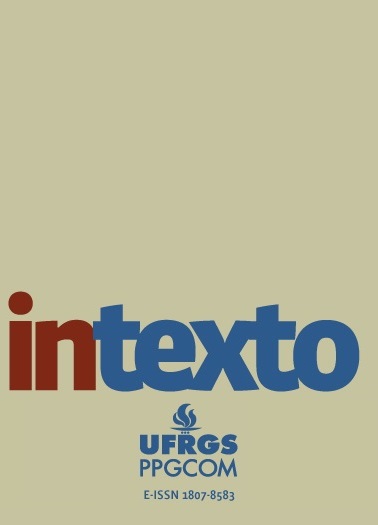The construction of fear in It: reflections on Andy Muschietti’s film, in the light of the fantastic genre
DOI:
https://doi.org/10.19132/1807-8583202152.92525Keywords:
Fear. Cinema. Fantastic. Andy Muschietti.Abstract
In 2017, Stephen King’s literary work It (1986) was made into a film by the hands of filmmaker Andy Muschietti. Born in Argentina in 1973, Muschietti gained notoriety in cinema due to the horror film Mama (2013). Muschietti has declared his passion for King’s work since he was 14 and acknowledged the challenge of adapting that novel of over a thousand pages for the screen. This article aims to make a reflection on the construction of fear in the film It (2017), in the light of studies in the fantastic genre. We build on the literary scholarship of Lovecraft (1973), Todorov (1981), Bauman (2008), França (2017) and Araújo (2018), among others, as well as Aumont (1995) and Messias (2016) in the field of film studies. We argue that, looking for tropes of the fantastic genre and considering a film to be a piece of text composed of sounds, images and shots, we can analyze how uncanny elements and other devices are deployed in It to build up the sensation of fear in the viewer.
Downloads
References
ARÁUJO, Naiara Sales. Literatura Fantásticafantástica, ficção científica e literatura gótica: interfaces e diálogos entrelaçados. São Luís: EDUFMA, 2018.
AUMONT, Jacques; MARIE, Michael. Dicionário teórico e crítico de cinema. Campinas: Papirus, 2001.
AUMONT, Jacques. A estética do filme. Campinas: Papirus, 1995.
AUMONT, Jacques; MARIE, Michel. A Análise do Filme. Lisboa: Edições Texto & Grafia, 2013.
BACHELARD, Gaston. A poética do espaço. 2. ed. São Paulo: WMF Martins Fontes, 2008.
BAUMAN, Zygmunt. Medo Líquidolíquido. Rio de Janeiro: Zahar, 2008.
FRANÇA, Júlio (org.). Poéticas do mal: a literatura do medo no Brasil. Rio de Janeiro: Bonecker, 2017.
FREUD, Sigmund. O estranho. In: FREUD, Sigmund. Obras psicológicas completas de Sigmund Freud. Rio de Janeiro: Imago, 1996. v. XVII, p. 237-273.
IT: a coisa. Direção: Andy Muschietti. [s.l]: NCidade : New Line Cinema, 2017. 1 DVD. (134 min), son., color.
KING, Stephen. Dança macabra: o fenômeno do horror no cinema, na literatura e na televisão dissecado pelo mestre do gênero. Rio de Janeiro: Objetiva, 2003.
LOVECRAFT, Howard Phillips. Supernatural horror in literatureHorror in Literature. New York: Dover Publications, 1973.
MANGUEL, Alberto. Contos de Horror do século XIX. São Paulo: Companhia das Letras, 2005.
MARTIN, Marcel. A linguagem cinematográfica. São Paulo: Brasiliense, 2003.
MASCARELLO, Fernando (org.). História do cinema mundial. Campinas: Papirus, 2006.
MESSIAS, Adriano. Todos os monstros da terra: bestiários do cinema e da literatura. São Paulo: EDUC, 2016.
METZ, Christian. Linguagem e cinema. São Paulo: Perspectiva, 1980.
MONTAIGNE, Michel de. Ensaio XVIII: do medo. In: MONTAIGNE, Michel de. Ensaios. São Paulo: Nova Cultural, 1991, . cap. 0, pp. 39-40.0-0.
PEREIRA, Diogo Nonato Reis. Considerações sobre o fantástico. Memento, Três Corações, v. 4, n. 2, p. 1-21, 2013.
RAMOS, Jesus. Diccionario del guión audiovisualGuión Audiovisual. Barcelona: Oceano Ambar, 2002.
REIS, Wellignson Valente dos; CASTRO, José Guilherme de Oliveira; TEIXEIRA, Lucilinda. Miguel Miguel: O fantástico traduzido para o cinema. Alusões, [s. l.], v. 6, n. 6, 2018.
ROGAK, Lisa. A biografia Stephen King: coração assombrado. Rio de Janeiro: Darkside Books, 2017.
SANTANA, Gelson. Cinema, comunicação e áaudio visual. São Paulo: Alameda, 2007.
SIJLL, Jennifer Van. A narrativa cinematográfica: contando histórias com imagens em movimento. São Paulo: WMF Martins Fontes, 2017.
TODOROV, Tzvetan. Introdução à literatura fantásticaLiteratura Fantástica. São Paulo: Perspectiva, 1981.
VANOYE, Francis; GOLIOT-LÉTÉ, Anne. Ensaio sobre a análise fílmica. Campinas: Papirus, 2012.
Downloads
Published
How to Cite
Issue
Section
License
Copyright (c) 2021 Naiara Sales Araújo, José Antonio Morae Costa

This work is licensed under a Creative Commons Attribution-NonCommercial 4.0 International License.
The copyright of works published in this journal belong to the authors, and the right of first publication is conceded to the journal. Due to the journal being of open access, the articles are of free use in research, educational and non-commercial activities.
Therefore, the journal uses the License Creative Commons Attribution (CC BY-NC 4.0), which allows sharing of work with acknowledgment of authorship.
Self-archiving (repository policy): authors are allowed to deposit all versions of their work in institutional or thematic repositories without embargo. It is requested, whenever possible, that the full bibliographic reference of the version published in Intexto (including the DOI link) be added to the archived text.
Intexto does not charge any article processing fees (article processing charge).















